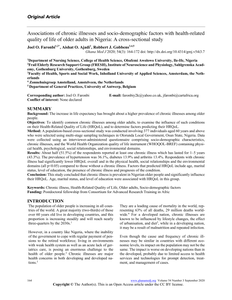Objective: The aim of this cross-sectional study was to determine the associations between frailty and multimorbidity on the one hand and quality of life on the other in community-dwelling older people. Methods: A questionnaire was sent to all people aged 70 years and older belonging to a general practice in the Netherlands; 241 persons completed the questionnaire (response rate 47.5%). For determining multimorbidity, nine chronic diseases were examined by self-report. Frailty was assessed by the Tilburg Frailty Indicator, and quality of life was assessed by the World Health Organization Quality of Life Instrument—Older Adults Module. Results: Multimorbidity, physical, psychological, as well as social frailty components were negatively associated with quality of life. Multimorbidity and all 15 frailty components together explained 11.6% and 36.5% of the variance of the score on quality of life, respectively. Conclusion: Health care professionals should focus their interventions on the physical, psychological, and social domains of human functioning. Interprofessional cooperation between health care professionals and welfare professionals seems necessary to be able to meet the needs of frail older people.
DOCUMENT

Background: The increase in life expectancy has brought about a higher prevalence of chronic illnesses among older people. Objectives: To identify common chronic illnesses among older adults, to examine the influence of such conditions on their Health-Related Quality of Life (HRQoL), and to determine factors predicting their HRQoL. Method: A population-based cross-sectional study was conducted involving 377 individuals aged 60 years and above who were selected using multi-stage sampling techniques in Olorunda Local Government, Osun State, Nigeria. Data were collected using an interviewer-administered questionnaire comprising socio-demographic characteristics, chronic illnesses, and the World Health Organization quality of life instrument (WHOQOL-BREF) containing physical health, psychological, social relationships, and environmental domains. Results: About half (51.5%) of the respondents reported at least one chronic illness which has lasted for 1–5 years (43.3%). The prevalence of hypertension was 36.1%, diabetes 13.9% and arthritis 13.4%. Respondents with chronic illness had significantly lower HRQoL overall and in the physical health, social relationships and the environmental domains (all p<0.05) compared to those without a chronic illness. Factors that predicted HRQoL include age, marital status, level of education, the presence of chronic illness and prognosis of the condition. Conclusion: This study concluded that chronic illness is prevalent in Nigerian older people and significantly influence their HRQoL. Age, marital status, and level of education were associated with HRQoL in this group.
DOCUMENT

Abstract Background: To assess the internal consistency reliability and construct validity of the Dutch version of the World Health Organization Quality of Life Instrument-Older Adults Module (WHOQOL-OLD). Methods: The psychometric properties of the Dutch WHOQOL-OLD were examined in a cross-sectional study using a sample of 1,340 people aged 60 years or older. Participants completed a Web-based questionnaire, the ‘Senioren Barometer’. Reliability was evaluated using Cronbach’s alpha and corrected item-total correlations. Construct validity of the Dutch WHOQOL-OLD was evaluated with confirmatory factor analyses, and correlations within and between scales, using scales WHOQOL-BREF, Short Form Health Survey (SF-12), Tilburg Frailty Indicator (TFI), and the Emotional and Social Loneliness Scale (ESLS).
DOCUMENT
